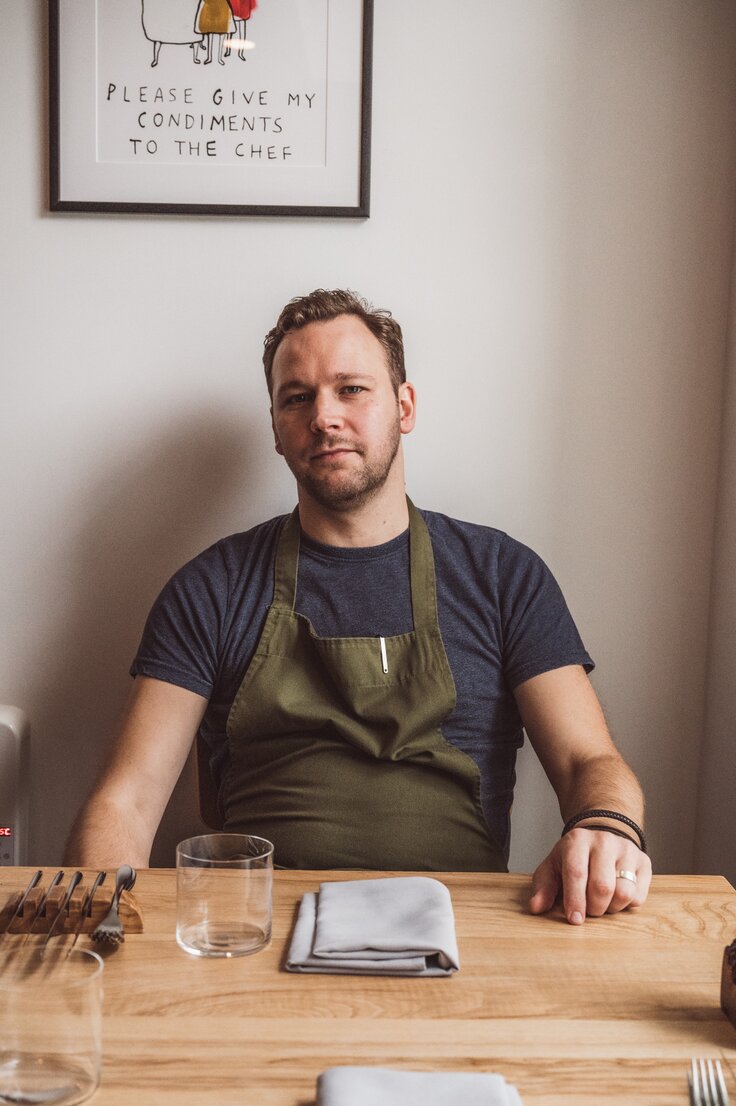
Article
5 min read
Cost control in hospitality: a guide by chef Scott Smith
Kitty Finstad
Nov 7, 2023
Chapters

Scott Smith, FHIOR. Copyright Planday 2023
5 ways for restaurants to manage spending in seasonal peaks
Bookings are healthy. Anticipation is rising. But so are energy bills. Rent. Wages. Expectations. How do you keep a lid on all your costs to keep customers (and your accountants) happy and end the year on a high?
One hospitality pro with several seasons – festive and otherwise – under his apron, shares his observations and red-hot ideas, as part of the Planday Seasonal Survival Guide.
Alongside with his wife and business partner, Laura, Scott Smith keeps a keen eye on every element of the FHIOR operation, from sourcing ingredients to menu planning to pricing strategies.
Here he offers some wisdom gleaned over his career in the kitchen and in front of endless spreadsheets.
Meet the team
Scott Smith: former Great British Menu competitor and chef patron of FHIOR
FHIOR: Edinburgh’s multi-award-winning, Michelin-recommended modern Scottish fine-dining restaurant
 Cutting back on staff hurts in the long run
Cutting back on staff hurts in the long run
Which costs can you control, and how do you prioritise them? What, if anything, can be cut?
When looking at the biggest cost shouldered by hospitality businesses, it’s tempting to go straight to wages. But that could easily create a downward spiral.
For Scott Smith, the team is FHIOR’s number one fixed cost:
“You could argue that‘s a cost you could cut, but this is not a manufacturing business – you’re not selling a product, you’re selling an experience. And the quality of that experience very much depends on the quality of the team.”
Scott thinks salaries are an area that needs greater investment, thanks to the red-hot recruitment landscape left in the wake of the pandemic and Brexit.
“If you start to cut your staffing levels to match a drop in revenue, you end up damaging the overall experience. You might survive in the short term, but in the long term you put your reputation at risk.”
“We could hire staff for the same salary as we offered last year, but then they can’t afford to pay their bills because of the cost of living – they won’t stay with us. So you have to pay a salary that makes them want to stay.”
Planday’s staff tracking software helps you understand how to optimise your staff, deliver flexibility and help retention.
 Raising costs? Elevate the experience too
Raising costs? Elevate the experience too
Higher costs might just be “costs” now. So what happens when wages and other outgoings surpass incoming revenues? Especially when previously familiar peak periods no longer guarantee profitability.
“We know we’re now going into a really busy time of year,” Scott states with confidence, “but at the same time, energy costs and inflation mean the margins are nowhere near what they used to be.”
How can you counteract narrowing margins against rising costs? By raising prices – but give it careful consideration first.
“We’ve always tried to be inclusive and affordable with our prices, which are good value for some and a treat for others. Next year though, we’ll have no choice but to raise our prices – not just because of inflation but because we don’t want to compromise the experience we give our customers."
“Which means we need to work really hard with our marketing to justify the new prices – they’ll be almost double what they were 18 months ago for our 10-course tasting menu. "
“Regulars will get it because they understand the value of the experience. But for first-time customers, we’ll have to be very bold and confident with our marketing and storytelling to make sure people feel comfortable spending that kind of money on an unknown experience. We don’t have a Michelin star, so we don’t have that advantage that says, ‘You can definitely blow your money with these guys!’’
Planday’s software helps you to track costs and revenue against rising staffing costs, making it easier to keep an eye on your bottom line.
 Be creative: get more from less
Be creative: get more from less
Try as they might, business owners can’t control everything – like energy costs. While food costs have increased, it is an area that kitchens can control. By dialling up the creativity with ingredients, they can make things go further – and create a great narrative at the same time.
“Food has definitely gone up in price for us,” says Scott, “but we can be cleverer with cheaper produce, because we have a really talented, well-paid team who know how to create better value on the plate.”
It’s a clever and deliberate pendulum swing towards more effective sourcing, creative menu writing and innovation around lesser-used ingredients and waste – something the FHIOR kitchen loves to experiment with.
“Right now, for example, we have a brilliant dessert on the menu made with plums. The skins are then dried and used to make a tea that appears in a kombucha on our soft drinks menu. So we’ve made a really interesting, tasty product out of waste.”
Savvy thinking can not only literally squeeze value out of ingredients but also have a positive (if subtle) effect on customer perceptions around the guiding values of the business when it comes to sustainability.
 Take time to talk to your suppliers
Take time to talk to your suppliers
Scott’s advice to save on food? Work with your suppliers directly and review your supply chain regularly.
“It’s about being very conscious of their pricing and using what’s not fashionable – supply and demand is a way to crank up prices. You’ll see prices for certain ingredients suddenly jump up because they’re all over Instagram.”
For chefs who like to experiment, Scott advocates selecting products or varieties that are ‘out of fashion’ and devising more interesting dishes from them.
“Take pork jowl – it’s what’s used to make guanciale, which is a very fashionable cured meat. We use it differently – we get a high yield out of it, it’s cheap to use and very tasty!
“Pork collar is another unfashionable cut and can be quite tough, but if you know how to marinate and cook it correctly to break down those proteins, it’s probably one of the tastiest. But if you’re interested in not saving money on ingredients, then just put the prime pork loin on the menu.”
 Scrutinise your costs across the whole business
Scrutinise your costs across the whole business
There will be lean times. Scott and the FHIOR team have been there.
“We were in a strange situation recently – for the first time since opening, even at full capacity, our incomings weren’t always covering our outgoings.”
With FHIOR’s wages bill peaking going into 2023, the team spent the first half of the year scrutinising every part of the business. One thing Scott knows is that successfully riding out loss-making months means never letting the coffers get too low.
“I think people sometimes forget about working capital, whether it’s a new business or ten years in. You can have a healthy P&L, but if your balance sheet is empty, you don’t have a business. We actively put money aside to keep running in case we find ourselves in a loss position.”
“It’s not about changing who you are, but about creating a model for the current climate that would benefit and future-proof both businesses.”
